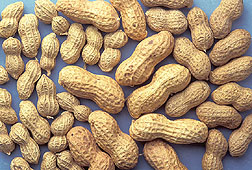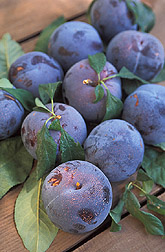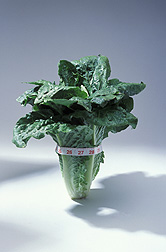This page has been archived and is being provided for reference purposes only. The page is no longer being updated, and therefore, links on the page may be invalid.
| July 2004 |
Sorghum--This Grain May Surprise You
Some of tomorrow's breads, waffles and noodles might be made with sorghum--today used mostly as animal feed. This nut-flavored grain provides fiber and healthful antioxidants, yet is free of gluten, the protein in wheat, rye and barley that causes an allergic condition known as celiac disease in an estimated 1 to 2 million Americans. ARS scientists in Manhattan, Kan., are studying the proteins in different varieties of sorghum to determine if any have the potential to provide the milling and baking qualities that gluten imparts to wheat doughs. That could, for example, lead to sorghum flours that yield delicious, finely textured specialty breads that everyone can enjoy. For details, contact Scott Bean, (785) 776-2725; USDA-ARS Grain Marketing and Production Research Center, Manhattan, KS. Peanuts Get Superb Protection Against Aflatoxin
Peanuts now have better protection from the Aspergillus flavus fungi that produce aflatoxin, a carcinogen. ARS scientists in Dawson, Ga., developed the protective material, which has been approved by the U.S. Environmental Protection Agency and is being sold as Afla-Guard by Circle One Global, Inc., of Cuthbert, Ga. Afla-Guard is made of spores of a harmless strain of A. flavus. When applied to barley kernels that are spread at the base of peanut plants, the spores multiply, taking space and nutrients that might otherwise be used by A. flavus strains or the aflatoxin-producing A. parasiticus. In field trials, Afla-Guard reduced aflatoxin by 70 to 90 percent after the first application, and by as much as 98 percent after repeated applications in subsequent years. For details, contact Joe W. Dorner, (229) 995-7408; USDA-ARS National Peanut Research Laboratory, Dawson, GA. Galaxy, the "Bagel Peach," Tastes Great!
Galaxy, a delicious new peach from ARS tree fruit breeders in California, is nicknamed "The Bagel Peach" for its flattened, bagel-like shape. Scientists made the peach available to breeders and nurseries for the first time last year, after more than a decade of testing in California. The peach might also flourish in southern peach-growing states. Galaxy has a delicate aroma, light-cream skin accented with an attractive red blush, and pleasantly textured white flesh that's sweet and juicy. It ripens at the same time of year--the third to fourth week of June--as a popular flat peach called Saturn, but is bigger. The scientists have provided more than 33,000 Galaxy buds to tree fruit nurseries, meaning that the distinctive peaches may begin showing up in supermarkets by 2006. For details, contact David W. Ramming, (559) 596-2823; USDA-ARS San Joaquin Valley Agricultural Sciences Center, Parlier, CA. Low Folate May Leave You Feeling Down
There's new evidence that folate, a B vitamin, might play a role in various stages of depression. In reviewing data from a questionnaire given to 3,000 people aged 15 to 39 years, researchers found that individuals with either major or mild forms of depression had lower blood levels of folate than did those who had never been depressed. Low folate levels are already known to be common in psychiatric patients and may hamper the effectiveness of antidepressant therapy. Scientists at the ARS Jean Mayer USDA Human Nutrition Research Center on Aging at Tufts University in Boston, Mass., conducted the study. Good sources of folate include beef liver, green leafy vegetables, pinto, kidney and garbanzo beans; and enriched grain products such as breakfast cereals, bread, pasta, flour and rice. Alcohol, certain medications and anemia can reduce the body's ability to absorb and use this essential nutrient. For information, contact Martha Savaria Morris, (617) 556-3302; ARS Jean Mayer USDA Human Nutrition Research Center on Aging at Tufts University, Boston, MA. Easier Detection of Livestock Growth Promoter
A feed additive that makes cows and pigs grow faster and produce leaner meat is now easier to detect, using either of two new methods developed by ARS scientists in Fargo, N.D. The techniques are a faster, more user-friendly alternative to high-performance liquid chromatography, or HPLC. Currently, HPLC is the chief means by which federal food safety inspectors determine residue levels of the additive, called ractopamine hydrochloride, in live animals or carcasses. The tests rely on special proteins known as monoclonal antibodies that the scientists built and patented. The antibodies seek out and bind to ractopamine. One approach, an ELISA (or enzyme-linked immunosorbent assay) yields the quickest results, since it can analyze many samples simultaneously--100 in five hours, for example. The second method, a biosensor assay, works best with low numbers of samples that require sequential analysis, such as on a production line moving at the rate of one every 10 minutes. For more information, contact Weilin L. Shelver, (701) 239-1423; USDA-ARS Red River Valley Agricultural Research Center, Fargo, ND. Bing Cherries Help Fight Arthritis, New Data Show
Plump, juicy Bing cherries, eaten fresh, may help people who suffer from the pain of gout or other forms of arthritic inflammation. That's according to results from a study with 10 healthy women, aged 22 to 40, who ate a special breakfast of 45 fresh, pitted Bing cherries. Scientists at the ARS Western Human Nutrition Research Center, Davis, Calif., and university colleagues conducted the investigation. The experiment was among the first to track anti-inflammatory effects of fresh Bing cherries in a carefully controlled test with healthy volunteers. Levels of uric acid--a compound the body uses to form painful urate crystals during a gout attack--decreased significantly in volunteers' blood (plasma) over the 5 hours after they ate the Bing-cherry breakfast. And, levels of urate removed from their bodies in urine increased over those 5 hours. The decrease in two key markers, or indicators, of inflammation--nitric oxide and C reactive protein--weren't large enough to be statistically significant. However, this downward trend agreed with that noted earlier in other scientists' test-tube studies of cherry extracts. Results of a follow-up study should be available later this year. The grower-sponsored California Cherry Advisory Board, Lodi, helped fund the study. For more information, contact Darshan S. Kelley (530) 752-5138; USDA-ARS Western Human Nutrition Research Center, Davis, CA. Trio of Superb New Plums From ARS Research Orchards
Three plump, delectable new plums from ARS each ripen at a different season and give fans of this healthful fruit a wider selection to choose from. Black Splendor plum ripens in early June. The juicy, beet-red flesh of this big fruit makes it an especially colorful addition to fresh-fruit salads. It is both bigger and earlier to ripen than the well-known Santa Rosa plum. Owen T, named for long-time tree fruit technician Owen Tanner, has blue-black skin with some touches of purple, and sweet, light-yellow flesh. This plum ripens in late June through early July. John W plums have purple skin dusted with light-tan specks, and luscious orange flesh. This fruit ripens in late August through early September, and was named in honor of the late ARS tree fruit and grape breeder John Weinberger. ARS scientists, after more than 10 years of research and testing, offered these plums to nursery operators, researchers and others for the first time in 2001 and 2002. Since then, the scientists have filled requests for more than 1,200 cuttings and more than 50,000 buds. The plums may begin showing up in supermarkets this year. For details, contact David W. Ramming, (559) 596-2823; USDA-ARS San Joaquin Valley Agricultural Sciences Center, Parlier, CA. Fast Food A Fast Track to Calories, Fats, Sugar?
Americans who eat fast food may be consuming higher amounts of calories, fats, carbohydrates, added sugars--and protein--than their non-fast-food-eating counterparts. That's according to ARS scientists at the Beltsville (Md.) Human Nutrition Research Center who analyzed data from more than 9,000 adult participants in a USDA food survey, conducted in the mid-1990's. Participants were surveyed for two nonconsecutive days. Those who consumed fast food on either or both days had higher odds of being overweight. In addition, fast-food meals included almost no milk, fruit or fruit juices. And, as the frequency of fast-food consumption increased, participants' intake of vitamins A and C, carotenes, calcium, phosphorus and magnesium decreased (Journal of the American College of Nutrition, vol. 23, pp. 163-168). Scientists attributed Americans' significant increase in fast-food consumption to such factors as longer work-week hours and an increase the number of U.S. fast food restaurants. But planning weekly meals and related grocery shopping should help adults become less reliant on fast-food meals. For more information, contact Shanthy A. Bowman, (301) 504-0619; USDA-ARS Beltsville Human Nutrition Research Center, Beltsville, MD. Vitamin E Helps Turkeys Fight Listeria
Adding vitamin E to turkey feed may further reduce the incidence of human illnesses caused by a foodborne pathogen, Listeria monocytogenes. The vitamin stimulates turkeys' immune systems, boosting production of white blood cells that fight the microbe. ARS scientists at the National Animal Disease Center, Ames, Iowa, and their colleagues at the University of Arkansas and Iowa State University, did the research using the alpha-tocopherol form of the vitamin. Plans call for testing vitamin E against Salmonella and Campylobacter, two other important foodborne pathogens. For more information, contact Irene V. Wesley, (515) 663-7291; USDA-ARS National Animal Disease Center, Ames, IA. Oat Antioxidant May Help Fight Arterial Plaque
A compound in oats may help prevent the buildup of plaque in arteries and thus lessen risk of heart disease. In laboratory tests, ARS-funded scientists at the Jean Meyer USDA Human Nutrition Research Center on Aging at Boston, Mass., exposed human arterial cells to the antioxidants, known as avenanthramides, that they had extracted from oats, and purified. They found that blood cells were significantly less able to stick to arterial wall cells that had been incubated with the antioxidants for 24 hours. Foods that provide oats include certain breads and muffins, as well as oatmeal and oat-based energy or breakfast bars. For details, contact Mohsen Meydani, (617) 556-3126; ARS Jean Mayer USDA Human Nutrition Research Center on Aging at Tufts University, Boston, MA. Egg-stending Eggs' Usefulness--Safely
If stored properly, eggs can be used beyond the sell-by date, ARS scientists in Athens, Ga., have found. In tests at the Poultry Processing and Meat Quality Research Unit, scientists found that eggs, if properly handled and refrigerated, didn't decrease markedly in quality during a 10-week test period. That's well beyond the current 30-day industry standard for storing eggs on supermarket shelves. Washing eggs according to current guidelines removes bacteria like Enterobacter or E. coli O157:H7 from their surface, reducing the chances that the microbes could get into them once you crack them open in your kitchen. An egg's shell and membranes under the shell provide a barrier that limits the ability of microbes to enter. A natural protective coating, called the cuticle, helps to preserve freshness and prevent microbial contamination of the egg. This coating is damaged or removed by processing, but some processors apply a thin layer of oil to help preserve each egg's quality. For more information, contact Michael Musgrove, (706) 546-3340; USDA-ARS Richard B. Russell Agricultural Research Center, Athens, GA. Waistline Statistics Reiterate Value of Healthy Eating
Meals that include fruits, vegetables, reduced-fat dairy products, and whole grains–and are low in red and processed meat, refined grains, fast foods and sodas--may result in smaller gains in Body Mass Index (or BMI), and your waistline. These are two key indicators of health. For example, abdominal weight gain and corresponding increase in waist circumference contribute more than does overall weight to the development of "metabolic syndrome"–the combination of abdominal obesity, high triglycerides, high blood pressure and poor blood sugar control that increase risk for heart disease and diabetes. ARS-funded scientists who studied records of the eating habits of about 500 healthy men and women found that adults who ate the greatest amounts of white bread, for instance, had three times greater increases in waist circumference in a year than their healthier-eating counterparts. Nutritional epidemiologists with the ARS Jean Mayer USDA Human Nutrition Research Center on Aging, Boston, Mass., conducted the study. For more information, contact P. Kirstin Newby, (617) 556-3357; ARS Jean Mayer USDA Human Nutrition Research Center on Aging at Tufts University, Boston, MA. New Software Increases Accuracy of Food Surveys
Nutritionists can now help food-survey volunteers more accurately recall what foods they ate--24 hours later--thanks to a software program that ARS researchers developed and are now fine-tuning. The program provides a carefully developed series of questions, or prompts, to help skilled interviewers elicit precise information. Preliminary results from one test of the software showed that 100 food survey volunteers, when questioned by phone and in-person interviews, recalled what they ate with about 98 percent accuracy, on the basis of total calories consumed. Food surveys are important! Health professionals, researchers and educators use data from these surveys to help detect, report and make recommendations about key trends that affect our health. Many chronic diseases and health conditions are directly related to our eating habits. Researchers at the ARS Beltsville (Md.) Human Nutrition Research Center developed the 24-hour recall software as the basis of their Automated Multiple-Pass Method, or AMPM for short. For details, contact Alanna Moshfegh, (301) 504-0170; USDA-ARS Beltsville Human Nutrition Research Center, Beltsville, MD. |
|
The United States Department of Agriculture (USDA) prohibits discrimination in all its programs and activities on the basis of race, color, national origin, gender, religion, age, disability, political beliefs, sexual orientation, and marital or family status. (Not all prohibited bases apply to all programs.) Persons with disabilities who require alternative means for communication of program information (Braille, large print, audiotape, etc.) should contact USDA's TARGET Center at (202) 720-2600 (voice and TDD). To file a complaint of discrimination, write USDA, Director, Office of Civil Rights, Room 326-W, Whitten Building, 14th and Independence Ave., SW, Washington, DC 20250-9410 or call (202) 720-5964 (voice or TDD). USDA is an equal opportunity provider and employer. |

